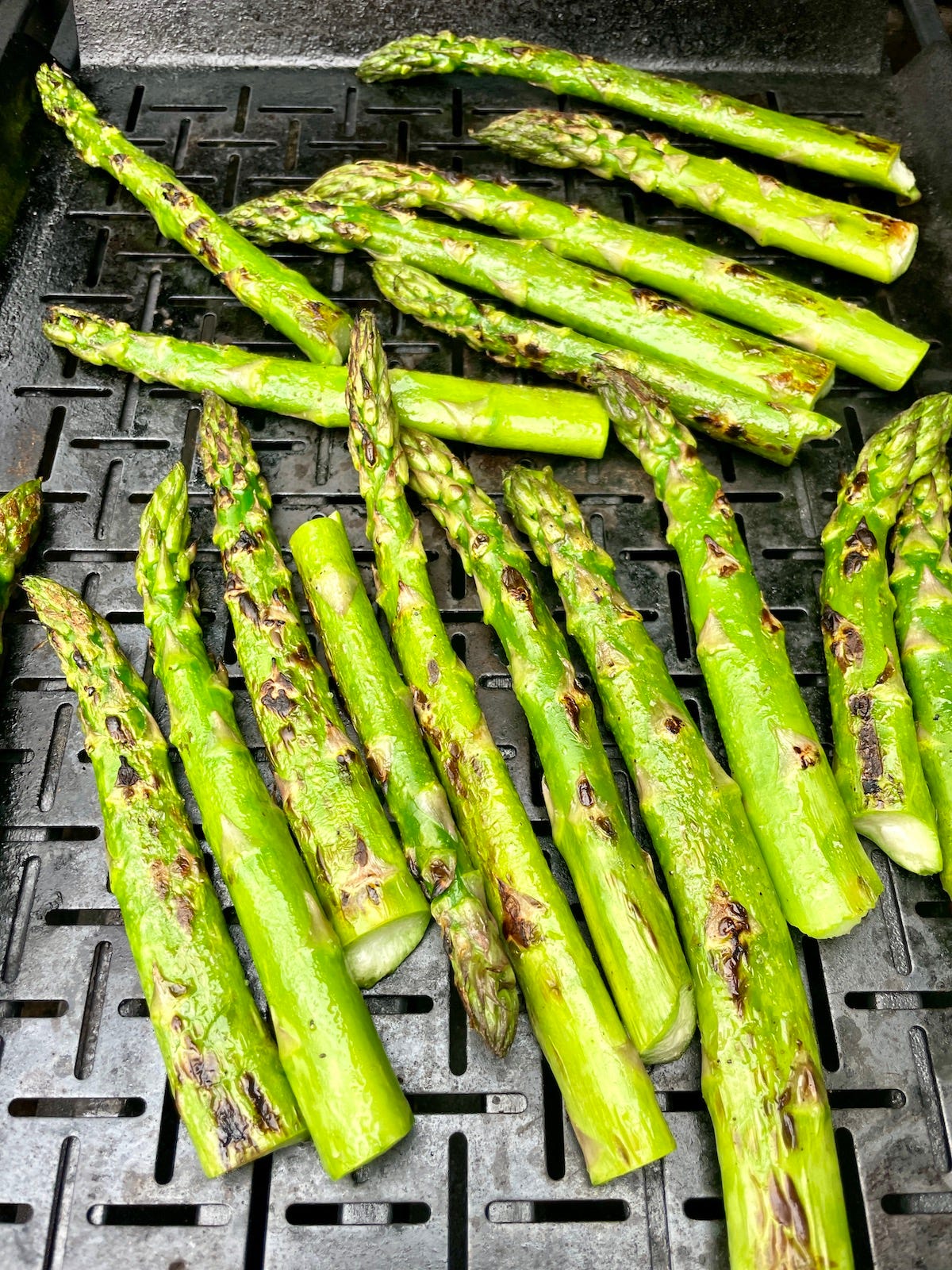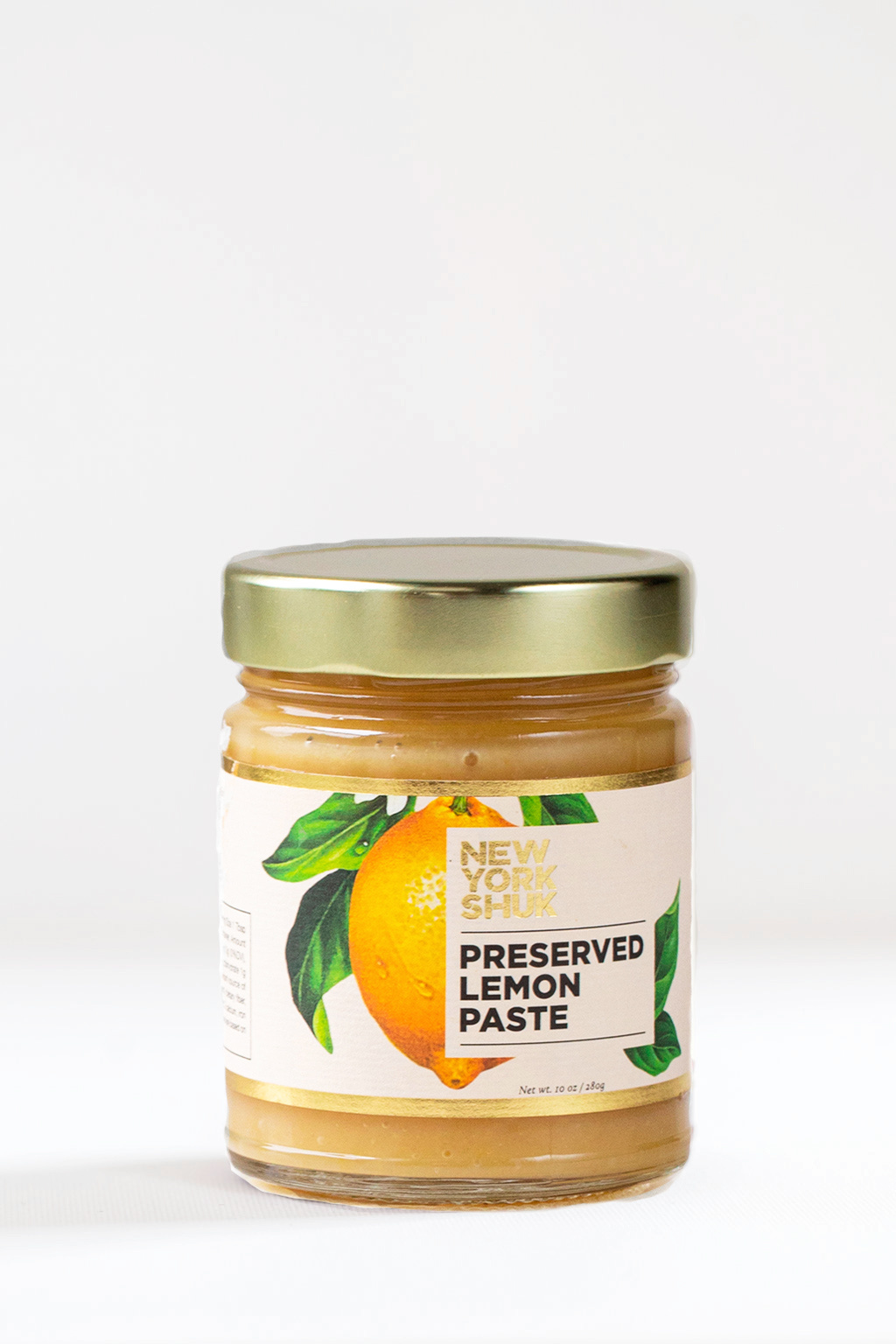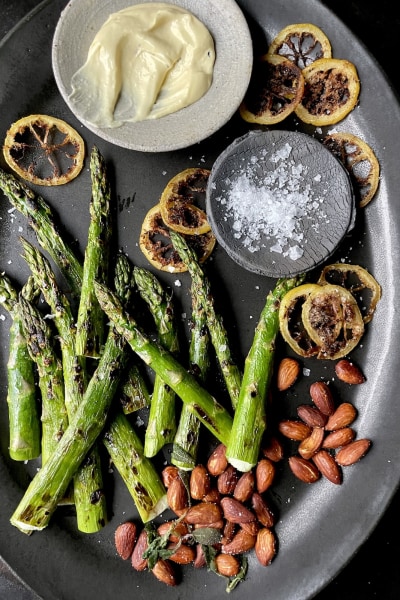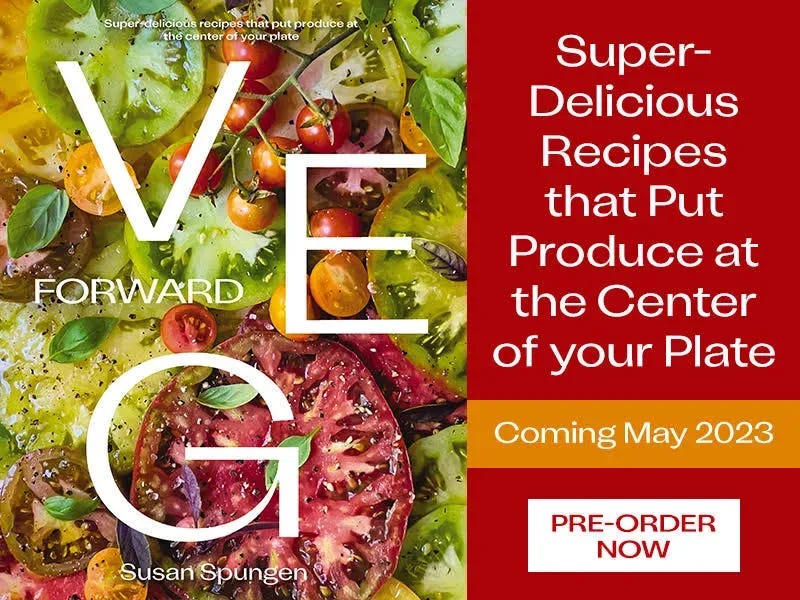Hello and Happy Friday!
I’ve got a little something for your weekend that is high-style and low-effort! I’m waiting patiently for Long Island asparagus (they might already be in the NYC greenmarket), but, in the meantime, the ones from the store are still more local than at other times of year. And I want them. I’m ready for them.
These were fat and flat, which made them perfect to cook on the grill. I have a gas grill just a few steps outside my kitchen door and I use it often, even in the winter. This time of year, it’s light and warm and I can linger outside a bit more to keep an eye on things so I don't burn them like I often do in the winter. I love that cooking on the gas grill is fast and easy and leaves less cleanup to do in the kitchen. I like to cook asparagus hot and fast, so they are still bright green. You can do the same thing in a hot oven, but it takes a bit longer.

Asparagus is the ultimate finger food and the perfect anchor for a snacking platter to serve with drinks for company, or for a weeknight dinner, perhaps with another snack-y item. We had this for dinner with some shrimp that I threw on the grill after the asparagus came off. It all cooks in under 15 minutes!
I wondered how some fried lemon slices would be with this assemblage, and also wondered if regular lemons — rather than Meyer lemons — would be too bitter. The answer is, borderline, and it depends on your tolerance for bitterness. My husband gobbled them all up, so for me they passed the test. If you can find Meyer lemons — which have been scarce in these parts this year — definitely use them. Otherwise, look for thin-skinned lemons, and slice them thinly. I used Wonderful brand seedless lemons. For years, I’ve been saying, “Why can’t we have seedless lemons?” and finally, we do! We decided that they might be more integrated if they were chopped up, so if you were going to serve this as more of a salad, you might want to smear the aioli on the bottom of the platter, sprinkle the chopped lemon peel over top, and maybe add some herbs. You could chop the almonds too. These flavors are great together, whatever form they take.

As I mentioned, I threw some shrimp on the grill and that was dinner! The shrimp were really good dragged through the aioli too. Ah yes, the aioli. I decided to use one of my favorite condiments to amp up the lemon flavor. Turns out, preserved lemon paste is just the thing to turn the always luxurious creamy sauce into something truly special. If you think you can’t make homemade mayo (which is what this is), or you’ve never tried, I highly recommend giving this a whirl (haha, so to speak). It’s so easy, and once you’ve made it, you’ll find yourself using the leftovers on everything. On sandwiches (of course), whisked into vinaigrette to make it creamier and lemony-er, or dabbed onto your grain bowl (we did this and can say that you should too).
The Secret Ingredient!
Have you used preserved lemons before in your cooking? Paula Wolfert was probably one of the first cookbook authors to introduce these pickled lemons to her American readers in her 1973 book Couscous and Other Good Food from Morocco, which I still have on my shelf. They’ve only grown in popularity since then. They are made from nothing more than lemons and salt, and a lot of time (like a month). If you’re lucky enough to have a lemon tree, this is a fantastic way to preserve the fruit, just like they had to in the olden days. The beautiful jars of lemons make great gifts. To cook with preserved lemons, you scoop out the insides and chop the now very flavorful peel to add zing and flavor to salads (especially grain salads), vinaigrettes, salsa verde, roasted vegetables, pastas, or the classic use: in a tagine (or any kind of stew). They will last for an extremely long time in the fridge, or properly sealed at room temperature.
I don’t know if it’s traditional or not, but one of my favorite companies, New York Shuk, makes a preserved lemon paste that has everything that preserved lemons have and more. Because they have already been blended into a smooth puree, these preserved lemons are ready to use. Just grab the jar and slip some into your dressings, or, like we’re doing today, aioli. One of my favorite uses for preserved lemon paste is to marinate chicken and seafood in it. The powerful flavor really penetrates and even tenderizes chicken, especially when combined with yogurt. For seafood, it’s a last-minute slather rather than a long marinade that adds flavor before your food hits the grill.
For the shrimp we enjoyed with this dinner, I used preserved lemon paste, shawarma spice, and matbucha, all from NY Shuk. A sprinkling of fresh mint (already from the garden!) made this a very quick and easy dish!
I highly recommend adding this condiment to your summer pantry!
The NY Shuk team kindly shared a discount code for Susanality readers! Use promo code SUSAN15% at check out to get 15 percent off your next order.
Snack-y Asparagus Platter with Preserved Lemon Aioli
Serves 4 to 6
I love the salty-tangy flavor that comes from the preserved lemon paste — a can't-live-without pantry staple for me — but you can still make this classic creamy sauce without it. Just substitute 4 teaspoons of fresh lemon juice for the paste. You can also include some extra-virgin olive oil in the total amount of oil, but not too much or it can make the aioli bitter. Use a little water at the end to thin the sauce if needed so it’s smooth and loose enough to easily drag an asparagus spear through it.
For the aioli:
2 cloves garlic, roughly chopped
2 large egg yolks
2 teaspoons water
1 ½ tablespoons preserved lemon paste (or finely chopped preserved lemons)
3/4 cup neutral oil, like peanut or safflower
For the fried lemons and almonds:
1 large (preferably seedless) lemon, well scrubbed and thinly sliced
1/2 cup vegetable oil (for frying)
1 cup whole raw almonds
Kosher salt
For the asparagus:
1 large bunch thick asparagus (about 1 pound), tough bottoms snapped off
2 to 3 teaspoons olive oil
Kosher salt and freshly ground pepper
Flaky sea salt
To make the aioli: combine the garlic, egg yolks, water, and lemon paste in the work bowl of a mini food processor, and whizz until smooth.
With the machine running, dribble in a drop or two of oil (use the perforated lid or feed tube of the food processor to do this), then a drop or two more.
Keep adding oil very, very, slowly at first and then working up to a steady stream until all the oil has been added. Scrape the sides to make sure there aren’t any puddles of oil and pulse briefly to incorporate.
Scrape into a bowl and refrigerate until needed.
Make the lemons and the walnuts: Bring a saucepan of water to a boil and drop in the lemon slices. Simmer for 2 minutes and scoop out onto a paper towel. Pat the top with another towel so they’re as dry as possible.
Heat the oil in a medium skillet over medium heat until hot (if you dip the edge of a lemon in it, it should sizzle), and then add them to the oil, one at a time, angling each slice away from you so it doesn’t splash.
Fry for 1 to 2 minutes per side, until thoroughly golden brown, and transfer using tongs or tweezers to a paper towel-lined plate. Sprinkle with salt.
Add the almonds to the oil and fry for 5 to 7 minutes, stirring gently, until a shade or two darker and starting to split. Watch them carefully, as the cooking time can vary a lot depending on how hot the oil is.
Transfer to another paper towel using a slotted spoon, and sprinkle with salt while hot. Let cool completely.
Make the asparagus: Coat the spears with oil, using only as much as you need, and sprinkle lightly with salt and pepper. Heat a gas grill to high, and preheat a grill platter if you have one. If roasting, heat oven to 500℉ with a baking sheet inside on the middle rack. Cook the asparagus until lightly charred but still bright green, 2 to 3 minutes per side on the grill or 6 to 7 minutes per side in the oven.
Arrange everything on a big platter and sprinkle with flaky sea salt. Serve at room temperature
Making Mayonnaise Tips:
Dribble oil slowly at first, and then in a steady stream.
Don’t run the machine longer than you have to so that the mayo doesn't overheat and break.
If it does break, start over with an additional egg yolk, adding the ruined mixture to the yolk, slowly, as you would add the oil.
Both regular and mini food processors have a perforated piece for adding oil slowly for mayonnaise and vinaigrettes.
If you don't have a food processor, you can follow the same procedure by hand, using a bowl and whisk, but you’ll need to chop the garlic until it forms a paste. It may not be quite as thick. Refrigerating it will thicken it up a bit.
Editor: Molly Ramsey








We are a week away from asparagus from the farm and I can’t wait! Thanks for this lovely suggestion and for telling us about preserved lemon paste, which I can’t wait to try.
How long do preserved lemons last? I have a big Meyer lemon tree and gave my neighbor a large amount of them a few years ago. She makes preserved lemons. As a gift she made me a HUGE jar of them. They have been in the fridge for a very long time. Like two years? They look exactly the same but I hate to throw them out because they are so beautiful. Do you think they are still good? Would love to try your recipe. This year has been a lousy year for lemons since we had a big hurricane and a lot of the leaves were blown off.